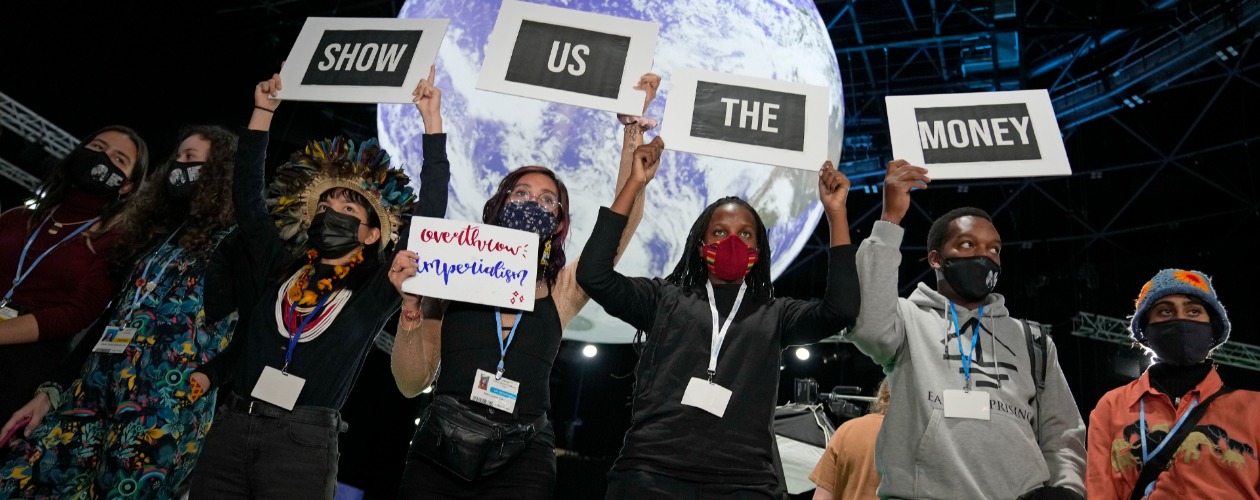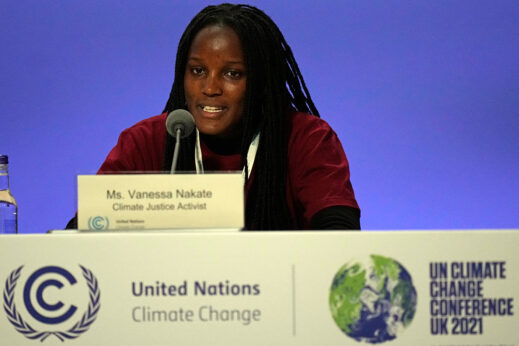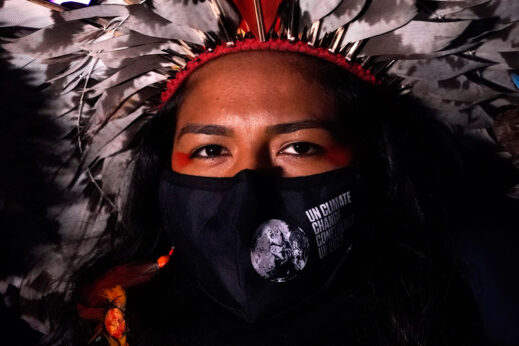
Leaders of 77 developing economies and China say $1.3 trillion a year is needed for them to transition to green energy, address loss and damage from extreme weather events, and adapt to the climate crisis. And those resources can only come from the wealthier developed countries.
So far, the advanced capitalist economies are either turning a deaf ear or coming up way short with guaranteed commitments at the U.N. Climate Change Conference (COP26) in Glasgow, Scotland. World leaders, environmental and civic leaders, and scientists are meeting to flesh out a global path to decarbonize the global economy by 2050 to avoid the worst consequences of global temperature increases.
“A COP26 without a concrete outcome on finance can never be successful. Finance is an enabler for ambition in developing countries,” said Ahmadou Sebory Toure, lead climate negotiator for Guinea.
Developing countries need half the $1.3 trillion sum for green energy transition and the other half for adaptation to climate change, including crop and habitat loss and resettling climate refugees. Climate-related disasters displaced over 10 million people between September 2020 and February 2021, and extreme weather caused $250 billion in damages in 2020 alone.
Poorer countries, including island nations, low-lying states, and those devastated by droughts and extreme weather events, did practically nothing to cause the climate crisis. The G20 wealthiest economies emitted 80% of global warming greenhouse gas (GHG) emissions, 40% by the U.S. and China. By comparison, African countries only account for 3% of GHG.
But now, developing economies face dire consequences and threats to their existence. Without more significant commitments to radically reduce GHG emissions, temperatures will rise to well over 2° Celsius, a death sentence for many.
The recovery and adaptation money needed to aid developing countries on the receiving end of advanced economies’ past resource exploitation and destruction essentially amounts to climate reparations. But developing countries fear wealthier nations will turn their backs, forcing them to fend for themselves, as has been the case during the COVID-19 pandemic. Anger and distrust toward richer countries have only deepened.

“Finance for adaptation is critical. But for many of us in vulnerable countries, adapting to climate change is no longer enough,” said Vanessa Nakate, a young climate leader from Uganda. “You cannot adapt to starvation. You cannot adapt to extinction. We must put loss and damage at the center of the COP26 negotiations.”
Many developing economies rely on fossil fuels, including from their territories, to achieve their development goals. As gas prices have risen, some are turning to cheaper but dirtier energy sources, like charcoal.
“When they say cut in Africa, what do they want to cut?” asked Titus Gwemende, Zimbabwe-based climate director at the Open Society Foundation. “There’s nothing to cut here. African countries are the ones on the receiving end of this problem. It’s the bigger emitters that should have the responsibility to cut,” he said. “We should be sensitive to history.”
The wealthier economies at COP26 are negotiating commitments to raise $100 billion a year for the Green Climate Fund (GCF) to assist developing countries over the next decade. These countries agreed to create the fund at the 2009 COP meeting in Copenhagen. The fund was intended to cover 2020-25 but is short and won’t be fulfilled until 2023, three years late, even with additional donations like the U.S.’ $11 billion commitment.

Last month, 150 organizations in wealthier countries called for $600 billion from developed nations to make up for earlier commitment shortfalls. But even then, the GCF is woefully inadequate. According to IRENA, the International Renewable Energy Agency, the global transition to green energy, energy efficiency, and upgrading power grids by 2050 will cost $120 trillion. But savings to society will eventually amount to $6 trillion a year, including hospitalizations and premature deaths, loss, and damage.
In 2020, the global economy invested a record $500 billion in green energy transition, mainly in developed countries. At the same time, G20 governments have spent $3.3 trillion subsidizing their fossil fuel industries and hundreds of millions more keeping climate refugees from crossing their borders, including by building walls. An estimated 200 million climate refugees will flee sea-level rise, droughts, heat, wildfires, desertification, and climate-exacerbated conflicts by 2050.
The main obstacle to more assistance is political resistance, including right-wing nationalism and economic resistance by the rich and fossil fuel industry. For example, if passed, President Joe Biden’s $1.75 trillion Build Back Better (BBB) legislation would allocate $500 billion for clean energy and other climate-related issues. However, the legislation has met total obstruction by Republicans and a handful of Democrats, who whittled it down.
Climate change is wreaking devastation on working-class communities in the U.S. Job loss and economic disruption will impact communities that rely on fossil fuels in the transition to clean energy. However, 3.3 million workers are already employed in the clean energy sector, three times the number in the fossil fuel industry. BBB and the just-passed Biden Infrastructure bill will address those transitions.
In 2019, the U.S. Climate Agency estimated the cost of building resilient communities able to withstand extreme weather, flooding, and sea-level rise would amount to “tens of billions” of dollars. The $1 trillion Biden Infrastructure bill adopted on Nov. 5 allocates $47 billion for resiliency infrastructure, including FEMA. The legislation is by far the most ever earmarked for such projects.
The BBB bill, which has yet to pass, contains the most extensive government investment in clean energy ever. It includes over $555 billion in clean energy tax credits, cleaning up Superfund sites, and electrification of public transit. The legislation would create thousands of jobs, especially in communities of color and communities affected by the transition to clean energy, and includes a Civilian Climate Corps and establishes a Green Bank to allow for lending to climate-related projects.
These allocations are just the beginning of the massive investments the U.S. will have to make to transition to clean energy and adapt to a changing environment. But developing nations are also looking for this level of commitment, one they desperately need. The world’s governments and people will either overcome the climate crisis through solidarity and justice or perish through nationalism, greed, and selfishness.










